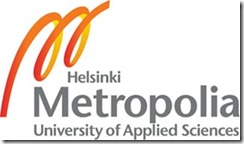Last week I went at Metropolia University, one of the most famous and probably the best school in the entire Finland. They have lot of interesting courses and I went there to visit the Media Design course, especially the one connected to 3d graphic, digital animation and, of course, videogame development.
The first person I met was Pasi Kaarto, the head of 3D animation & visualisation studies, and mostly important a pioneer of computer graphic. I introduced my self as “the italian”, always speaking about something, leaving no empty space in our conversation 🙂
He was really polite and introduced me to the 3rd year class; they were/are working on an animation project that is really impressive as number of animated characters, joints, bones, vertex and so on. The animation is supervised by Jaana Wahlfors, an experienced director and Markus Elo, a really creative guy. At that moment of production they had a little pre-rendered sequences to verify the animations, but the most impressive thing, as said, were the number of animations they were doing. I was really surprised about the student’s interest in the subject, and the passion they put in that project. Everyone had his own computer and every student worked actively in the main pipeline, using Lightwave/3ds max for modelling (maybe UV mapping too, I didn’t asked), Photoshop for texturing, Maya for rigging and mentalRay for materials and render.
I really would like my students will have the same motivation and the same hardware support…this made me a bit depressed about it. I see the same passion in my student’s eyes, but I know the possibilities given to them are a bit different. 
The trip was only at the beginning! we went to see the 1st class portfolio and what to say? Students already prepared for working experience. I think they don’t have so many things to learn regarding the technical aspects of 3D computer graphic. They had interiors, microphones, guitars, animated logos, tables with dishes, characters and animated things. The teacher asked them to animate some stuff without bones, so they invented accessible solutions to do this task. One of them created a mechanical tank with an incredible animation: detailed, expressive, dynamical and funny. I was also surprised by the work of another guy that created everything in Blender; he looked really interested in speed, showing me a speed-modelling exercise in which he crafted a car in about 15 minutes (if I don’t remember wrong).
This class was tutored by Lauri Huikuri, one of the most skilled lecturers. He was extremely prepared on all the aspects of 3D and visualization; it was so great speaking with people with the same passion…here at home sometime I feel a bit lonely.
We had a quick break at the 4th floor with Elina Vaeroe, the responsible of metropolia’s international affairs. We spoke about “secret” affairs and I discovered Metropolia’s fine arts and conservation courses worked in Naples with a local group for the reconstruction of a “Domus Pompeiana”. They gave me a book and reading it I discovered that Finish people are studying Pompei since a log time, around the beginning of the last century…interesting. 
After this meeting we went to Helsinki centre to have lunch in a really cool restaurant. Time ago Berlusconi said that he coundn’t live in Finland because of food (one of his world famous bad jokes ;p), I think he didn’t tried good dishes. In this restaurant we met Peke Huuhtanen a visiting lecturer in Metropolia. He is actually a skilled animator employed at AnimaVitae Ltd. We spoke a lot about some subjects: Life in Finland vs life in Italy, schools and work in Helsinki vs schools and work in Milano, differences between our institutes, way to think, how to approach to work, football, weather, food, animation, UDK, renderer, realtime, and of course Alan Wake. I didn’t knew this game was a Finnish production and that inside the development team there are some Metropolia ex students. This is a proof of what I said at the beginning: Metropolia rocks!
After lunch they led me at the airport and after some troubles with planes I came back in Milano.
Nice trip, see you again in October!
A special thanks for this meeting goes to Mona Anniina Taponen that made it possible and to Pamela De Lorenzi that organized my travel.
Helsinki Metropolia University





















